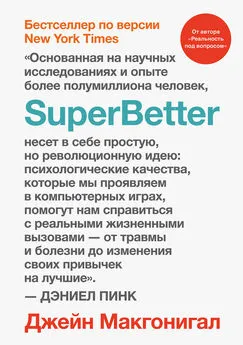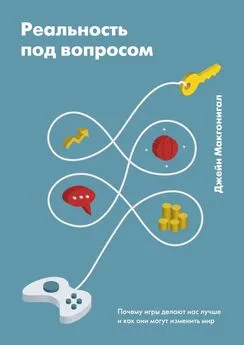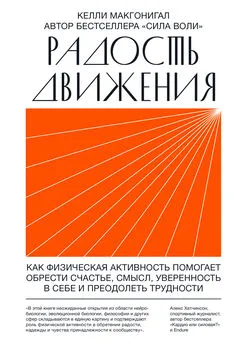Джейн Макгонигал - SuperBetter
- Название:SuperBetter
- Автор:
- Жанр:
- Издательство:Манн, Иванов и Фербер
- Год:2018
- Город:Москва
- ISBN:9785001174301
- Рейтинг:
- Избранное:Добавить в избранное
-
Отзывы:
-
Ваша оценка:
Джейн Макгонигал - SuperBetter краткое содержание
Книга будет интересна всем, кто готов освоить игровой подход для решения повседневных задач.
SuperBetter - читать онлайн бесплатно полную версию (весь текст целиком)
Интервал:
Закладка:
46
Mihaly Csikszentmihalyi . Activity and Happiness: Towards a Science of Occupation // Journal of Occupational Science. 1993. № 1 (1). P. 38–42.
47
Brenda E. Mansfield et al. A Possible Physiological Correlate for Mental Flow // Journal of Positive Psychology. 2012. № 7 (4). P. 327–333.
48
Jenova Chen . Flow in Games (And Everything Else) // Communications of the ACM. 2007. № 50 (4). P. 31–34.
49
Dennis Scimeca . How Playing Casual Games Could Help Lead to Better Soldiers // Ars Technica. 2013. October 5.
50
Carmen V. Russoniello, Kevin O’Brien, Jennifer M. Parks . EEG, HRV and Psychological Correlates While Playing Bejeweled II: A Randomized Controlled Study // Studies in Health Technology and Informatics. 2009. № 144. P. 189–192.
51
C. V. Russoniello, Kevin O’Brien, and Jennifer M. Parks . The Effectiveness of Casual Video Games in Improving Mood and Decreasing Stress // Journal of Cyber Therapy and Rehabilitation. 2009. № 2 (1). P. 53–66.
52
Метаанализ — анализ результатов нескольких анализов (исследований).
53
Brian A. Primack et al. Role of Video Games in Improving Health-Related Outcomes: A Systematic Review // American Journal of Preventive Medicine. 2012. № 42 (6). P. 630–638.
54
Практика внимательности ( англ . mindfulness meditation) — традиционная для буддизма форма медитации.
55
Jayne Gackenbach, Johnathan Bown . Mindfulness and Video Game Play: A Preliminary Inquiry // Mindfulness. 2011. № 2 (2). P. 114–122.
56
Paul Grossman et al. Mindfulness-Based Stress Reduction and Health Benefits: A Meta-Analysis // Journal of Psychosomatic Research. 2004. № 57 (1). P. 35–43; Stefan G. Hofmann et al. The Effect of Mindfulness-Based Therapy on Anxiety and Depression: A Meta-Analytic Review // Journal of Consulting and Clinical Psychology. 2010. № 78 (2). 169 p.; Alberto Chiesa, Alessandro Serretti . Mindfulness-Based Stress Reduction for Stress Management in Healthy People: A Review and Meta-Analysis // Journal of Alternative and Complementary Medicine. 2009. № 15 (5). P. 593–600.
57
Jonathan R. Krygier et al. Mindfulness Meditation, Well-Being, and Heart Rate Variability: A Preliminary Investigation into the Impact of Intensive Vipassana Meditation // International Journal of Psychophysiology. 2013. № 89 (3). P. 305–313.
58
Thomas William Rhys Davids , trans. Dialogues of the Buddha. 1899 // reprint Delhi: Motilal Banarsidass, 2000.
59
Michiel M. Spapé et al. Keep Your Opponents Close: Social Context Affects EEG and fEMG Linkage in a Turn-Based Computer Game // PLOS ONE. 2013. № 8 (11). e78795.
60
Marco Iacoboni . Imitation, Empathy, and Mirror Neurons // Annual Review of Psychology. 2009. № 60. P. 653–670; Kenneth R. Leslie, Scott H. Johnson-Frey, Scott T. Grafton . Functional Imaging of Face and Hand Imitation: Towards a Motor Theory of Empathy // Neuroimage. 2004. № 21 (2). P. 601–607; Ruth Feldman et al. Mother and Infant Coordinate Heart Rhythms Through Episodes of Interaction Synchrony // Infant Behavior and Development. 2011. № 34 (4). P. 569–577; Piercarlo Valdesolo, Jennifer Ouyang, David Desteno . The Rhythm of Joint Action: Synchrony Promotes Cooperative Ability // Journal of Experimental Social Psychology. 2010. № 46 (4). P. 693–695; Piercarlo Valdesolo, David Desteno . Synchrony and the Social Tuning of Compassion // Emotion. 2011. № 11 (2). 262 p.
61
Guillaume Chanel, J. Matias Kivikangas, Niklas Ravaja . Physiological Compliance for Social Gaming Analysis: Cooperative Versus Competitive Play // Interacting with Computers. 2012. № 24 (4). P. 306–316; Inger Ekman et al. Social Interaction in Games Measuring Physiological Linkage and Social Presence // Simulation and Gaming. 2012. № 43 (3). P. 321–338.
62
Barbara Fredrickson. Love 2.0: How Our Supreme Emotion Affects Everything We Think, Do, Feel, and Become. New York: Hudson Street Press, 2013.
63
Tiffany Field, Brian Healy, William G. Leblanc . Sharing and Synchrony of Behavior States and Heart Rate in Nondepressed Versus Depressed Mother-Infant Interactions // Infant Behavior and Development. 1989. № 12 (3). P. 357–376.
64
Greg J. Stephens, Lauren J. Silbert, Uri Hasson . Speaker — Listener Neural Coupling Underlies Successful Communication // Proceedings of the National Academy of Sciences. 2010. № 107 (32). P. 14425–14430.
65
Bethany E. Kok, Barbara L. Fredrickson . Upward Spirals of the Heart: Autonomic Flexibility, as Indexed by Vagal Tone, Reciprocally and Prospectively Predicts Positive Emotions and Social Connectedness // Biological Psychology. 2010. № 85 (3). P. 432–436.
66
Robert W. Levenson, John M. Gottman . Marital Interaction: Physiological Linkage and Affective Exchange // Journal of Personality and Social Psychology. 1983. № 45 (3). 587 p.
67
Fredrickson . Love 2.0.
68
Charles J. Walker . Experiencing Flow: Is Doing It Together Better Than Doing It Alone? // Journal of Positive Psychology. 2010. № 5 (1). P. 3–11.
69
Simo Järvelä et al. Physiological Linkage of Dyadic Gaming Experience // Simulation and Gaming. 2014. № 45 (1). P. 24–40.
70
Sarah M. Coyne et al. Game on… Girls: Associations Between Co-Playing Video Games and Adolescent Behavioral and Family Outcomes // Journal of Adolescent Health. 2011. № 49 (2). P. 160–165; Laura M. Padilla-Walker, Sarah M. Coyne, Ashley M. Fraser . Getting a HighSpeed Family Connection: Associations Between Family Media Use and Family Connection // Family Relations. 2012. № 61 (3). P. 426–440; Lydia Buswell et al. The Relationship Between Father Involvement in Family Leisure and Family Functioning: The Importance of Daily Family Leisure // Leisure Sciences. 2012. № 34 (2). P. 172–190.
71
Daphne Bavelier et al. Brains on Video Games // Nature Reviews Neuroscience. 2011. № 12 (12). P. 763–768; J. Wainer, K. Dautenhahn, B. Robins, F. Amirabdollahian . A Pilot Study with a Novel Setup for Collaborative Play of the Humanoid Robot KASPAR with Children with Autism // International Journal of Social Robotics. 2014. № 6 (1). P. 45–65; Bill Ferguson et al. Game Interventions for Autism Spectrum Disorder // Games for Health Journal. 2012. № 1 (4). August issue. P. 248–253.
72
Video Games Can Benefit Autistic Children: Study // Agence France-Presse, 2014. March 7.
73
Valdesolo, Ouyang, Desteno . The Rhythm of Joint Action: Synchrony Promotes Cooperative Ability; Natalie Sebanz, Harold Bekkering, Günther Knoblich . Joint Action: Bodies and Minds Moving Together // Trends in Cognitive Sciences. 2006. № 10 (2). P. 70–76; Lynden K. Miles, Louise K. Nind, C. Neil Macrae . The Rhythm of Rapport: Interpersonal Synchrony and Social Perception // Journal of Experimental Social Psychology. 2009. № 45 (3). P. 585–589.
74
Nintendo — японская компания, специализирующаяся на создании видеоигр и игровых консолей.
75
C. Daniel Batson et al. Empathy, Attitudes, and Action: Can Feeling for a Member of a Stigmatized Group Motivate One to Help the Group? // Personality and Social Psychology Bulletin. 2002. № 28 (12). P. 1656–1666; C. Daniel Batson et al. Empathy and Attitudes: Can Feeling for a Member of a Stigmatized Group Improve Feelings Toward the Group? // Journal of Personality and Social Psychology. 1997. № 72 (1). 105 p.
76
Jennifer N. Gutsell, Michael Inzlicht . Empathy Constrained: Prejudice Predicts Reduced Mental Simulation of Actions During Observation of Outgroups // Journal of Experimental Social Psychology. 2010. № 46 (5). P. 841–845.
77
Games for Peace: Bridging Conflict Through Online Games, http://gamesforpeace.org, acessed April 20, 2014.
78
Donghee Yvette Wohn et al. The ‘S’ in Social Network Games: Initiating, Maintaining, and Enhancing Relationships // Proceedings of the 44th Hawaii International Conference on System Sciences. 2011. IEEE. P. 1–10.
79
Donghee Yvette Wohn et al. Building Common Ground and Reciprocity Through Social Network Games // CHI EA’10 Extended Abstracts on Human Factors in Computing Systems. 2010. ACM. P. 4423–4428.
80
Sabine Trepte, Leonard Reinecke, Keno Juechems . The Social Side of Gaming: How Playing Online Computer Games Creates Online and Offline Social Support // Computers in Human Behavior. 2012. № 28 (3). P. 832–839.
81
Jonathan Oxford, Davidé Ponzi, David C. Geary . Hormonal Responses Differ When Playing Violent Video Games Against an Ingroup and Outgroup // Evolution and Human Behavior. 2010. № 31 (3). P. 201–209; Samuele Zilioli, Neil V. Watson . The Hidden Dimensions of the Competition Effect: Basal Cortisol and Basal Testosterone Jointly Predict Changes in Salivary Testosterone After Social Victory in Men // Psychoneuroendocrinology. 2012. № 37 (11). P. 1855–1865.
82
Erno Jan Hermans, Peter Putman, Jack Van Honk . Testosterone Administration Reduces Empathetic Behavior: A Facial Mimicry Study // Psychoneuroendocrinology. 2006. № 31 (7). P. 859–866; Paul J. Zak et al. Testosterone Administration Decreases Generosity in the Ultimatum Game // PLOS ONE. 2009. № 4 (12). e8330.
83
Allan Mazur, Elizabeth J. Susman, Sandy Edelbrock . Sex Difference in Testosterone Response to a Video Game Contest // Evolution and Human Behavior. 1997. № 18 (5). P. 317–326.
84
Justin M. Carré, Susan K. Putnam, Cheryl M. McCormick . Testosterone Responses to Competition Predict Future Aggressive Behaviour at a Cost to Reward in Men // Psychoneuroendocrinology. 2009. № 34 (4). P. 561–570; Justin M. Carré, Cheryl M. McCormick, Ahmad R. Hariri . The Social Neuroendocrinology of Human Aggression // Psychoneuroendocrinology. 2011. № 36 (7). P. 935–944; Pranjal H. Mehta, Amanda C. Jones, Robert A. Josephs . The Social Endocrinology of Dominance: Basal Testosterone Predicts Cortisol Changes and Behavior Following Victory and Defeat // Journal of Personality and Social Psychology. 2008. № 94 (6). 1078 p.
Читать дальшеИнтервал:
Закладка:








